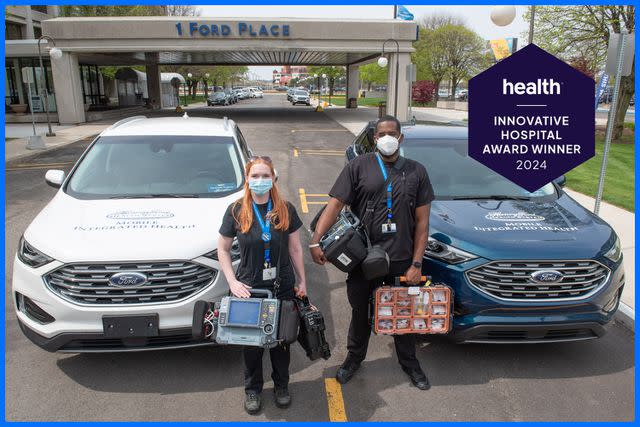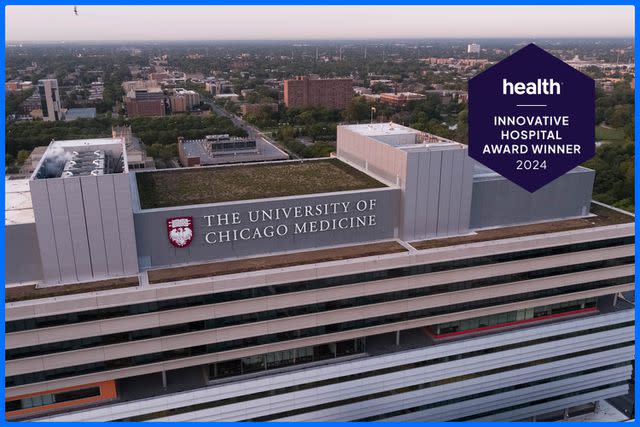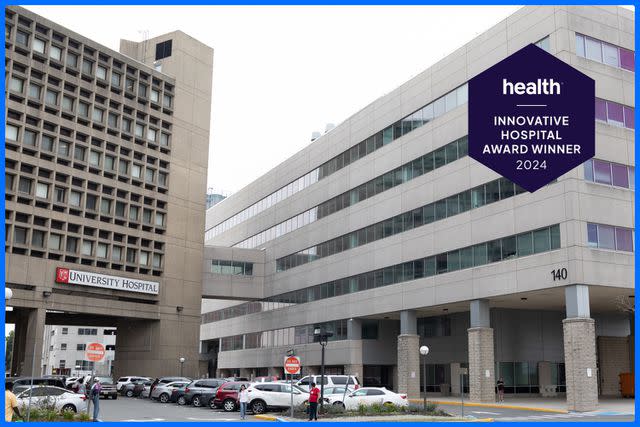Innovative Hospital Awards 2024
These 12 medical institutions offer fresh, advanced approaches to patient care.

When it comes to people’s health, innovation is more than just adopting the latest technology. It means finding new or better ways to improve the quality of care a patient receives, or their access to care. Health.com is pleased to recognize the following hospitals and health systems for their innovative programs, many of which were created to improve patient outcomes.
How we chose the winners
To choose the winners, our experienced writers and editors carefully reviewed submissions and qualifying programs. In order to qualify, a hospital or health system must have a program that directly improves patient care by providing specialized, unique, or groundbreaking offerings that have not been widely available. The programs must also be five years old or less or have been revised or updated within that timeframe.
Here are the winners of Health's 2024 Innovative Hospital Awards.
University of Maryland Charles Regional Medical Center
Program: Mobility Rounds and Reports

Courtesy of the University of Maryland Charles Regional Medical Center
When someone is hospitalized, spending too much time in bed can make them more likely to experience complications (muscle weakness, skin breakdown, hospital-acquired infections) and increase their risk for falls. These risks can often be prevented if they start moving earlier.
In December 2020, experts at the University of Maryland Charles Regional Medical Center (UMCRMC) took a look at their own institution’s mobility records, hoping to improve patient safety. When they found out-of-bed activity was low, they launched the Mobility Rounds and Reports initiative, which safely mobilizes patients who need movement to heal. That might mean having them to sit up in bed for daily meals or taking them for walks in the facility’s corridors.
On a regular basis, an interdisciplinary team completes its rounds at UMCRMC, reviewing mobility reports with staff, pinpointing any barriers to patient movement, and addressing them. UMCRMC’s nursing staff is provided with additional education that helps them evaluate each patient’s mobility status and figure out what’s needed to make improvements.
The hospital’s program has led to tangible gains in its mobility score; more patients are getting up and moving, reducing their risk for complications. Six months before it started its mobility rounds, the facility had an average out-of-bed activity score of 26 percent; six months after it began, that score had risen to 85 percent. Hospital data also showed a 14.3 percent decrease in the average number of inpatient falls per 1,000 patients.
George Washington Center for Integrative Medicine/ GW Hospital
Program: Long COVID Program

Courtesy of George Washington Center for Integrative Medicine
People with lingering symptoms resulting from a COVID-19 infection may be faced with issues beyond illness and disability. The complexity of Long COVID can require frequent medical visits over long periods that might not be covered by insurance. This leaves patients with two options: forgoing the care they need or racking up significant medical debt. To address this, the George Washington Center for Integrative Medicine (GWCIM) implemented a Long COVID program in 2022, providing patients with affordable access to comprehensive care.
The program is run by an interdisciplinary team who can help arrange provider visits and other services patients need (physical therapy, speech and language therapy, psychotherapy, dietary counseling). Member Ashley Drapeau, PA-C, L.Ac, is keenly aware of what Long COVID patients face because she, too, experiences its symptoms. She and Mikhail Kogan, MD, facilitate Long COVID Virtual Group Meets that allow patients to share weekly medical visits for a monthly cost of $100. The group also addresses topics such as integrative treatment, rehabilitation, nutrition, and mindfulness. It’s a safe, supportive space for patients.
GWCIM’s Long COVID program has so far served 3,000 individuals, and more than doubled the number of its participants over the past year. In the future, the hospital hopes to get the funding to reach more people in lower socioeconomic groups.
Related: Why Is It So Difficult for Long COVID Patients to Get Diagnosed and Treated?
Trinity Health
Program: TogetherTeam Virtual Connected Care

Nurses are a critical part of patient care teams, but nursing shortages exacerbated by the pandemic have created numerous challenges for medical institutions. In 2023, Trinity Health created its TogetherTeam Virtual Connected Care program, which improves patient care while providing support to on-site nursing staff. It introduces virtual nurses to patients’ care teams.
How does it work? Registered nurses who work virtually can connect with patients using the TVs in their rooms, along with high-resolution cameras. They can access medical records and even zoom in for an exam using the camera. This is done in collaboration with the patient’s direct care registered nurse and on-site nursing assistant. They work as a seamless team.
Virtual nurses may be experienced caregivers who have come out of retirement, or those who want less demanding roles. Because the job is virtual, they can continue working for longer than they might in an on-site position. They are stationed on local campuses where they can access the patients’ complete medical records and use high-tech cameras. The virtual nurses are often more experienced than the on-site nurses, and can provide mentoring and support.
Hospital surveys show that this program improves patient satisfaction, in no small measure because virtual nurses are quickly accessed, which reduces waiting time while providing customized care. TogetherTeam has so far served more than 1,158 patients across 50 nursing units in 10 states; Trinity Health plans to expand it to its network of 88 hospitals nationwide.
Henry Ford Health
Program: Mobile Integrated Health

Courtesy of Henry Ford Health
Paramedics have long responded to medical emergencies and cared for patients in crisis. Henry Ford Health’s Mobile Integrated Health program seeks to reduce the need for this emergency care by having them pay regular in-home visits to high-risk patients.
People are usually referred to the program by an emergency department, inpatient unit, or primary care provider. Candidates are usually those considered to be at high risk for readmittance to the hospital. Instead, they are visited over the course of several weeks by a paramedic in their homes. They may be given a physical exam, have fluids or IV medications administered, undergo a review of their medications, and even receive medical treatment while being virtually supervised by another healthcare provider. Paramedics also help people transition from hospital to home by explaining their discharge instructions.
By having paramedics provide non-emergency follow-up care, Henry Ford Health has been able to decrease its number of emergency visits and hospital readmissions. The program, which was launched in 2020, has already served 9,250 patients. Administrators hope to extend the program’s coverage area soon, and aim to provide blood draws at home for patients who are bedridden or have mobility or transportation issues.
SSM Health Sun Prairie Pediatrics Clinic
Program: Reach Out and Read

Reach Out and Read is a program aimed at children from birth through age five, which aims to increase awareness around the importance of early literacy. At annual visits with a clinic’s pediatricians, kids receive a new book, and parents get the opportunity to learn more about the benefits of reading out loud to their children, which include enhanced brain development, better language skills, social-emotional growth, stronger relationship bonds, and easier entry to school.
Clinics with a Reach Out and Read program will order and track the books they give out, connecting with local libraries for resources, submitting bi-annual reports, and fundraising. The Sun Prairie Pediatrics Clinic started their program in August 2023; the clinic serves at least 116 kids at their well-child visits every year. Its organizers aim to provide diverse and inclusive books for children of all backgrounds, so they can see themselves and others better represented.
Vanderbilt University Medical Center
Program: Long COVID Support Group

Courtesy of Vanderbilt University Medical Center
During the early days of the COVID pandemic, clinicians at Vanderbilt University Medical Center (VUMC) recognized that people living with Long COVID and their families needed a safe space to get not just physical help, but mental health support. The facility began offering free telehealth support groups in June 2021 for the patients they’d been seeing with the condition.
Today, these weekly group meetings are facilitated by James Jackson, PsyD, a research professor of medicine and director of behavioral health at the ICU Recovery Center at VUMC, who is joined by a therapist and social worker. The groups follow a peer-support model, and “focus on helping patients find ways to accept and even embrace limitations, empowering them to find the courage to take risks and do hard things, and to navigate what we widely refer to as their ‘new normal,’” said Jackson.
The Long COVID support groups have already served some 200 patients, but the team at VUMC isn’t stopping there—they hope to expand their sessions across the country and are working with other institutions interested in starting their own groups.
UCSF Medical Center
Program: UCSF Cancer Immunotherapy Toxicity Evaluation (CITE)

Immunotherapy is commonly used in the treatment of cancer to help a patient’s immune system target and fight the disease. But just like any other treatment, it has its side effects, known as “immune-related adverse events (irAEs).” These can involve just about any organ system in the body, which makes them especially challenging to address. Managing them effectively requires the oncologist treating the cancer to collaborate with a specialist on the affected organ system.
To bridge the gaps between providers, UCSF created the Cancer Immunotherapy Toxicity Evaluation program (CITE), the only one of its kind on the West Coast. CITE fosters partnerships between 30+ UCSF faculty members across nine medical subspecialties and five departments as they collaborate on irAE management.
The program has clear benefits. Connecting different departments and specialties streamlines referrals, which can encourage faster, more comprehensive patient care. CITE’s practice coordinator expedites subspecialty consultations, tests, or procedures and gives referring providers access to a team of oncologists and specialists. The program keeps patients apprised of the latest approaches to managing irAEs and preventing treatment interruptions. Experts in different disciplines also come together through CITE to reach consensus on irAE management.
CITE was launched in April 2023, but it’s already served 208 patients. The growth in patient referrals has been steady, as has the increase in external referrals from community providers.
Related: Personalized mRNA Vaccines Could Significantly Reduce Risk of Melanoma Relapse
University of Chicago Medicine
Program: Transgender Clinic for Affirmation and Reproductive Equity (CARE)

Courtesy of UCSF Medical Center
It can be challenging for transgender and gender-diverse patients to find healthcare providers who understand the issues surrounding gender identity and have experience providing care to patients like them. To help people navigate this space, the University of Chicago Medicine launched its Transgender Clinic for Affirmation and Reproductive Equity (CARE) in May 2021.
CARE is run by two OB-GYNs, and visits to it are covered by insurance. The clinic provides a place for people who are transgender to get inclusive medical care and learn about everything from hormones and surgery to advice on starting a family. (Its most requested services are gender-affirming hysterectomies, family-building consultations, and hormone therapies.)
CARE patients have access to a dedicated representative who they can contact with any issues or follow-up questions. Where necessary, the clinic will refer patients to other medical providers who can meet their specific needs and provide them with quality care. Administrators hope their clinic will be a model for other healthcare systems seeking to serve transgender patients.
Montefiore Health System
Program: Community Health Worker Institute (CHWI)

Courtesy of Montefiore Health System
The environments in which people live, work, and spend their leisure time are known as “social determinants of health” (SDOH), and they have a major impact on our health and well-being. This is especially evident in lower-income areas such as the Bronx, a borough of New York City, where people don’t have access to as many resources as those in other parts of the city.
Montefiore Health System introduced its Community Health Worker Institute program (CHWI) in 2021 as a way to fill the gaps between medical care and social services. It embeds local experts within designated clinical teams so they can represent the language and lived experience of the Bronx communities they serve. These workers receive training and education that helps them better identify patients’ social needs and understand how to work with them to arrange services.
CHWI serves patients in many locations across Montefiore Health System, including primary care, pediatrics and family locations, and obstetrics-gynecology clinics. Its dedicated lab not only does its own research on SDOH, but analyzes data to measure the impact that community health workers have on the lives of local residents. (Success means that patients get at least one service from a community health worker, or they make progress on a social need.)
Since CHWI was introduced in 2021, 24 community health workers have been trained to provide services to Bronx families. Data from CWHI shows that 92 percent of the families who have received its services saw progress after meeting with a community health worker. Future plans include extending the program’s coverage to include all three Montefiore adult hospitals in the Bronx.
Memorial Hermann Health System
Program: Collaboration with Midi Health

Courtesy of Memorial Hermann
Menopause often brings life-altering changes and challenging symptoms. It affects everyone differently, but not everyone gets the care or guidance they need. To increase patients’ options, Memorial Hermann Health System has partnered with Midi Health, a virtual care clinic that helps women to navigate the hormonal transitions of perimenopause and menopause.
Patients at Memorial Hermann are referred to Midi by their healthcare providers, who use an online referral form. The service’s nurse practitioners, nurse midwives, physicians, and naturopathic physicians specialize in midlife health, and will draw up a personalized care plan for patients. After the visit, Midi will share a patient’s information with their referring provider so their whole care team can be connected. Any in-person screenings, surgeries, biopsies, or ultrasounds will be performed by a provider or specialist at Memorial Hermann.
The hospital’s collaboration with Midi began in 2023, and its administrators hope to keep using it to serve patients in need in the greater Houston, Texas, area. The care is covered by major insurance plans, but for those without insurance, there are cash payment options.
Nemours Children’s Health
Program: Children’s Voice Program

Courtesy of Nemours Children's Health
In the world of pediatrics, it can be difficult to secure appointments with multiple specialists and coordinate care between providers. When more than one specialist is needed for an evaluation or diagnosis, treatment can stall, particularly if one provider has a packed schedule.
Nemours Children’s Voice Program, offered in Delaware, New Jersey, and Pennsylvania, makes it easier for pediatric patients with vocal issues to find help. The first time families visit one of Nemours’ dedicated clinics, they are able to connect with both otolaryngologists and speech-language pathologists, which saves them considerable time: “They can be diagnosed by otolaryngology and begin treatment with speech-language pathology all in one visit,” said Nicole Aaronson, MD, MBA, the site director for the clinic’s New Jersey location.
When a new voice clinic patient calls, their appointment is scheduled using a template built to accommodate a time when both otolaryngologists and speech-language pathologists are in the clinic. Both specialists take the patient’s history and conduct a physical exam together, allowing for a more cohesive treatment plan from the beginning. A psychologist who specializes in communication disorders is also available to help address mental health issues.
The clinics see about 100 voice patients at present; Dr. Aaronson and her team hope to expand to additional sites. They also plan to conduct patient surveys to track program satisfaction in the future.
University Hospital
Program: Weight Management Center of Rutgers New Jersey Medical School

Courtesy of University Hospital, Newark, NJ
As with many health conditions, there isn’t a one-size-fits-all approach to addressing obesity. Being located in a city and state with a high obesity rate, the experts at University Hospital in Newark, New Jersey, recognized the need for a multidisciplinary approach; they launched the Weight Management Center of Rutgers New Jersey Medical School in 2021 to provide patients with guidance and information around medical, surgical, dietary, and physical activity concerns.
Rather than split up its medical and lifestyle services, the program combines both to provide patients with customized care. It has an impressive team of specialists in obesity medicine, including endocrinologists, bariatric surgeons, behavioral health specialists, physical therapists, and nutritionists, all of whom work together.
The center’s bariatric surgery program helps patients sustain long-term weight loss, and that translates into other health improvements, reducing or eliminating health conditions associated with obesity, such as high blood pressure, sleep apnea, heart disease, and Type 2 diabetes. Treatment plans can be nonmedical, medical/surgical, or a combination of both.
Fact checked by Melinda Dodd.
For more Health.com news, make sure to sign up for our newsletter!
Read the original article on Health.com.

